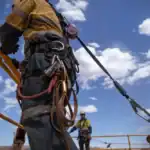
When is it permissible to paint a ladder? Never is the safest answer. Making an old ladder look new doesn’t make it safe, but that fresh paint of coat might fool you into thinking it is.
This is one ladder safety principle you need to know if you’re responsible for equipment in your workplace or use a ladder for your job. But it’s obviously not the only one.
Our guide covers the regulations and safety rules you must follow when using ladders at work, so you can be confident your equipment is compliant, functional and safe.
When is it Permissible to Paint a Ladder? and Other Ladder Safety Questions
When is it Safe to Use a Ladder?
First, it’s important to address a common misconception: The use of ladders in workplaces is allowed.
A surprising number of people believe that the Health and Safety Executive (HSE) banned ladders from British workplaces because they couldn’t trust people to use them safely. This is completely false.
However, there are some restrictions. Before using a ladder for work at height, a competent person must have risk assessed the planned work. They must conclude there’s no safer alternative (such as scaffolding) or a safer alternative is impractical.
Generally, ladders are only considered safe for low-risk work activities that can be completed in 30 minutes or less. You must also be sure the type of ladder selected suits the work and can be set up safely.
Who Can Use a Ladder Safely?
Workers must be competent or supervised by someone competent to use a ladder safely.
Competence is a combination of experience, knowledge and training. So, to safely use a ladder, you must understand the equipment, the risks of using it and how to mitigate those risks.
When is it Permissible to Paint a Ladder?
Painting a ladder isn’t ever permissible because it isn’t safe.
HSE guidelines state that a ladder should be checked and confirmed as safe before every use. Paint can conceal signs of wear and damage, making it difficult to carry out the required pre-use check.
So, it’s best to keep ladders unpainted. This way, workers can conduct sufficient pre-use checks and be confident a ladder that looks safe actually is.
What Should You Check Before Using a Ladder?
A successful pre-use check should catch obvious faults. The HSE advises these checks be performed by the person using the ladder at the beginning of the working day or after any changes, such as dropping the ladder or moving it from a dirty area to a clean one. Here’s what to look for:
- Stiles: Check that the stiles are not bent or damaged. Damaged stiles can cause the ladder to buckle or collapse.
- Feet: Make sure the feet are not missing, worn or damaged. Proper contact with the ground is crucial to prevent slipping. When moving the ladder from soft or dirty ground to a smooth surface, ensure the feet are clean and make proper contact with the ground.
- Rungs: Inspect the rungs for any signs of being bent, worn, missing or loose. Faulty rungs can lead to ladder failure.
- Locking Mechanism: Verify that the locking mechanism is working properly. Check for bent, worn or damaged components. Ensure any locking bars are fully engaged to prevent the ladder from collapsing.
- Stepladder Platform: If using a stepladder, check that the platform is not split or buckled. An unstable platform can cause the ladder to become unstable or collapse.
- Steps or Treads: Inspect the steps or treads for contamination that could make them slippery. Ensure the fixings are secure as loose steps can collapse.

Do You Only Need to Carry Out Pre-Use Checks?
While pre-use checks are essential for ladder safety, they’re not the only inspections needed. Under the Provision and Use of Work Equipment Regulations (PUWER), all work equipment must be regularly inspected for defects or other safety issues.
Inspections are more detailed than pre-use checks, so it takes more knowledge and training to conduct them. The outcomes must also be recorded to prove compliance and document a ladder’s condition over time.
When Should You Conduct Inspections?
There are no set inspection intervals, but there are recommendations based on how often you use your ladder:
- Ladders used daily should be inspected every three months.
- Ladders used weekly should be inspected every six months.
- Ladders used monthly should be inspected every year.
These are only suggested timeframes. It’s up to the employer to determine when their ladders should be inspected. This decision should be based on the manufacturer’s guidance and the environment in which the ladder is used and stored.
Ladders must also be inspected after any suspected damage or after modifications have been made.
What Do You Do If a Ladder Fails an Inspection or Check?
Immediately remove a ladder from service and label it accordingly. Make it clear to others that the ladder is unsafe and cannot be used.
After isolating the ladder, assess the issue and take the appropriate action. You may be able to manage simple faults in-house, but more extensive repairs might need to be handled by a professional. Whatever happens, it’s important to track and document the process.
When is it Permissible to Paint a Ladder? Key Takeaways
- Painting a ladder is not permissible as it can conceal critical faults.
- Always conduct thorough pre-use checks and regular inspections to ensure ladder safety.
- If a ladder fails an inspection, immediately take it out of service and address the issues. A competent person should inspect the repaired ladder before reuse.
- Ensuring ladder safety through proper maintenance and training is essential for a safe work environment.
Ladder Inspection Training
Ensuring your team understands and implements proper ladder safety practices is crucial. We offer a comprehensive Ladder Inspection Training course designed to enhance your ladder safety and maintenance knowledge and skills.
This online course provides a thorough understanding of ladder inspections. It covers essential topics, including legal requirements, ladder types and parts, common faults and inspection procedures. It also includes a free digital checklist covering every step of a detailed inspection, ensuring all checks are compliant and recorded accurately.






















